
The Hawker Siddeley Nimrod is a retired maritime patrol aircraft developed and operated by the United Kingdom. It was an extensive modification of the de Havilland Comet, the world's first operational jet airliner. It was originally designed by de Havilland's successor firm, Hawker Siddeley; further development and maintenance work was undertaken by Hawker Siddeley's own successor companies, British Aerospace and, later, BAE Systems.
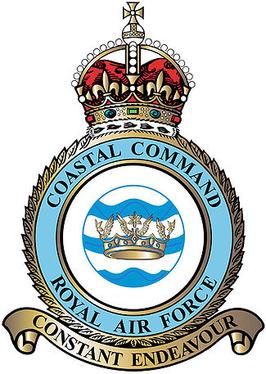
RAF Coastal Command was a formation within the Royal Air Force (RAF). It was founded in 1936, when the RAF was restructured into Fighter, Bomber and Coastal commands and played an important role during the Second World War. Maritime Aviation had been neglected in the inter-war period, due to disagreements between the Royal Navy (RN) and RAF over the ownership, roles and investment in maritime air power.
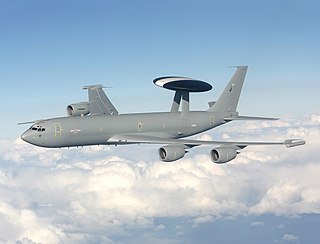
An airborne early warning and control (AEW&C) system is an airborne radar early warning system designed to detect aircraft, ships, vehicles, missiles and other incoming projectiles at long ranges, as well as performing command and control of the battlespace in aerial engagements by informing and directing friendly fighter and attack aircraft. AEW&C units are also used to carry out aerial surveillance over ground and maritime targets, and frequently perform battle management command and control (BMC2). When used at altitude, the radar system on AEW&C aircraft allows the operators to detect, track and prioritize targets and identify friendly aircraft from hostile ones in real-time and from much farther away than ground-based radars. Like ground-based radars, AEW&C systems can be detected and targeted by opposing forces, but due to aircraft mobility and extended sensor range, they are much less vulnerable to counter-attacks than ground systems.

The Avro Shackleton is a British long-range maritime patrol aircraft (MPA) which was used by the Royal Air Force (RAF) and the South African Air Force (SAAF). It was developed by Avro from the Avro Lincoln bomber, which itself had been a development of the famous wartime Avro Lancaster bomber.

A maritime patrol aircraft (MPA), also known as a patrol aircraft, maritime reconnaissance aircraft, maritime surveillance aircraft, or by the older American term patrol bomber, is a fixed-wing aircraft designed to operate for long durations over water in maritime patrol roles — in particular anti-submarine warfare (ASW), anti-ship warfare (AShW), and search and rescue (SAR).
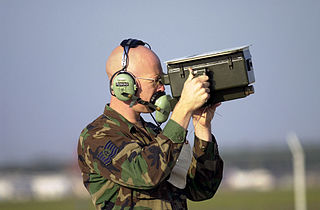
Identification, friend or foe (IFF) is a combat identification system designed for command and control. It uses a transponder that listens for an interrogation signal and then sends a response that identifies the broadcaster. IFF systems usually use radar frequencies, but other electromagnetic frequencies, radio or infrared, may be used. It enables military and civilian air traffic control interrogation systems to identify aircraft, vehicles or forces as friendly, as opposed to neutral or hostile, and to determine their bearing and range from the interrogator. IFF is used by both military and civilian aircraft. IFF was first developed during World War II, with the arrival of radar, and several friendly fire incidents.

Direction finding (DF), or radio direction finding (RDF), is the use of radio waves to determine the direction to a radio source. The source may be a cooperating radio transmitter or may be an inadvertant source, a naturally-occurring radio source, or an illicit or enemy system. Radio direction finding differs from radar in that only the direction is determined by any one receiver; a radar system usually also gives a distance to the object of interest, as well as direction. By triangulation, the location of a radio source can be determined by measuring its direction from two or more locations. Radio direction finding is used in radio navigation for ships and aircraft, to locate emergency transmitters for search and rescue, for tracking wildlife, and to locate illegal or interfering transmitters. During the Second World War, radio direction finding was used by both sides to locate and direct aircraft, surface ships, and submarines.

Number 120 Squadron or No. CXX Squadron is a squadron of the Royal Air Force which was established as a Royal Flying Corps unit late in World War I, disbanded a year after the end of the war, then re-established as a RAF Coastal Command squadron during World War II. Although disbanded again a month after Victory in Europe Day, during and after World War II it operated almost continuously, with maritime patrol aircraft; most recently with the Hawker Siddeley Nimrod, based at RAF Kinloss in Scotland until the type's withdrawal in March 2010. The squadron was disbanded again the following year. No. 120 Squadron stood up again in April 2018 at RAF Lossiemouth and became the first squadron to be equipped with the Boeing Poseidon MRA1 anti-submarine warfare (ASW) aircraft on 31 October 2019.

High-frequency direction finding, usually known by its abbreviation HF/DF or nickname huff-duff, is a type of radio direction finder (RDF) introduced in World War II. High frequency (HF) refers to a radio band that can effectively communicate over long distances; for example, between U-boats and their land-based headquarters. HF/DF was primarily used to catch enemy radios while they transmitted, although it was also used to locate friendly aircraft as a navigation aid. The basic technique remains in use as one of the fundamental disciplines of signals intelligence, although typically incorporated into a larger suite of radio systems and radars instead of being a stand-alone system.
The Rainbow Codes were a series of code names used to disguise the nature of various British military research projects. They were mainly used by the Ministry of Supply from the end of the Second World War until 1958, when the ministry was broken up and its functions distributed among the forces. The codes were replaced by an alphanumeric code system.
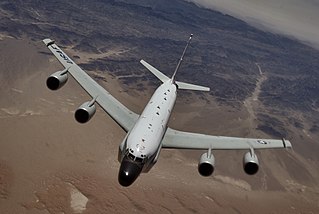
Signals intelligence operational platforms are employed by nations to collect signals intelligence, which is intelligence-gathering by interception of signals, whether between people or between machines, or mixtures of the two. As sensitive information is often encrypted, signals intelligence often involves the use of cryptanalysis. However, traffic analysis—the study of who is signalling whom and in what quantity—can often produce valuable information, even when the messages themselves cannot be decrypted.

The DRDO Airborne Early Warning and Control System (AEW&CS) is a project of India's Defence Research and Development Organisation to develop an airborne early warning and control system for the Indian Air Force. It is also referred to as NETRA Airborne Early Warning and Control System (AEW&CS).

No. 18 Group of the Royal Air Force was a group active from 1918 to 1919, and from 1938 to 1996.

The British Aerospace Nimrod AEW3 was a proposed airborne early warning (AEW) aircraft which was to provide airborne radar cover for the air defence of the United Kingdom by the Royal Air Force (RAF). The project was designed to use the existing Nimrod airframe, in use with the RAF as a maritime patrol aircraft, combined with a new radar system and avionics package developed by Marconi Avionics.

The Fairey Gannet AEW.3 is a variant of the Fairey Gannet anti-submarine warfare aircraft intended to be used in the airborne early warning (AEW) role on aircraft carriers of the Royal Navy. It was introduced to service in 1959 to replace the obsolete Douglas Skyraider, and was intended as an interim solution until the planned introduction of a new, purpose built AEW platform for use on the planned CVA-01 aircraft carriers. Neither the new aircraft carriers nor the new AEW aircraft were proceeded with, and the Gannet AEW.3 remained in service until the last aircraft carrier that could operate it was retired in 1978.
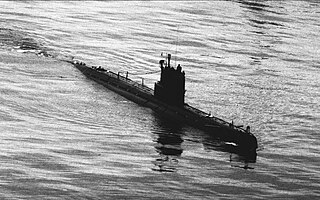
Autolycus or Sniffer was a submarine detection system designed to detect diesel-engined submarines from aircraft. It was designed to detect exhaust fumes from their diesel engines. Named after the mythical Greek, Autolycus, who took part in the search for the Golden Fleece, it was developed by the British during the early Cold War period. The first version of Autolycus was deployed on Avro Shackleton aircraft in the mid-1950s, with an improved version re-appearing in the mid-1960s.

744 Naval Air Squadron is a Naval Air Squadron of the Royal Navy's Fleet Air Arm. It was initially active in 1943, based in Nova Scotia. A second 744 NAS was formed, in early 1944, in Northern Ireland, for Merchant Aircraft Carrier training, meaning the first iteration was re-designated 754 NAS. The squadron's primary focus turned to Anti-submarine warfare training, which then further developed into trialing new submarine detection technology, ending in 1956. In 2018 it reformed as the Mission Systems and Armament Test and Evaluation Squadron.
Radar, Air to Surface Vessel, or ASV radar for short, is a classification used by the Royal Air Force (RAF) to refer to a series of aircraft-mounted radar systems used to scan the surface of the ocean to locate ships and surfaced submarines. The first examples were developed just before the opening of World War II and they have remained a major instrument on patrol aircraft since that time. It is part of the wider surface-search radar classification, which includes similar radars in ground and ship mountings.

On 30 April 1990, a Royal Air Force Avro Shackleton AEW Mk II aircraft, of No. 8 Squadron RAF, based at RAF Lossiemouth, crashed into a hill on the Isle of Harris whilst attempting to land at RAF Benbecula. All ten crew on board died in the crash, which included the wing commander who was in charge of No. 8 Squadron at the time. The Shackleton was the last of the fleet to be involved in a fatal accident, and the type was withdrawn from RAF service in 1991.
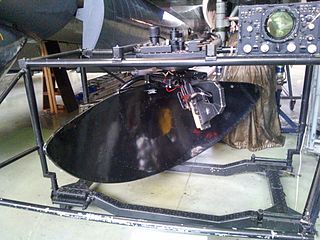
The AN/APS-20 was an airborne early warning, anti-submarine, maritime surveillance and weather radar developed in the United States in the 1940s. Entering service in 1945, it served for nearly half a century, finally being retired in 1991. Initially developed at Massachusetts Institute of Technology (MIT) under Project Cadillac, the radar was developed to be carried by aircraft to extend the sensor range of ships by placing a radar at altitude. Although developed for carrier-borne operation, first being installed in the single-engined General Motors TBM-3W Avenger, it was also used in larger four-engined airframes, the last being a fleet of Avro Shackleton AEW.2 which were converted from maritime patrol aircraft. Similarly, although developed for detecting aircraft, it saw extensive service in anti-submarine and maritime patrol roles and was one of the first radars to be used in researching extreme weather like hurricanes by agencies like the Environmental Science Services Administration (ESSA). As well as the United States, the radar was used by a large number of services in other countries, including the French Navy, Japan Maritime Self-Defense Force (JMSDF), Royal Air Force (RAF) and Royal Canadian Air Force (RCAF). Early versions of the radar could see a low-flying aircraft at 65 nautical miles and a ship at 200 nautical miles. This was improved, so that later versions had a range against aerial targets of 115 nautical miles.





















